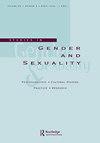幻阳具?
Q3 Social Sciences
引用次数: 0
摘要
针对斯特拉耶将幻肢现象与跨性别者的经历联系起来的文章,我强调神经科学与精神分析之间的共同特征。我的评论对斯特拉耶的一些说法提出了质疑。运用精神分析的概念,我参考了克里斯汀·布鲁克-罗斯(Christine Brooke-Rose)的一篇短篇小说,以及罗伯特·斯托勒(Robert Stoller)的一个臭名昭著的案例,这个案例在精神分析文献中被忽视了,那是一本书的篇幅,研究了一位经历过阴茎幻觉的女性患者。这使我能够讨论有争议的阳具概念,并将其与这里提出的原始和刺激的论点联系起来。本文章由计算机程序翻译,如有差异,请以英文原文为准。
A Phantom Phallus?
ABSTRACT Responding to Straayer’s article linking the phenomenon of phantom limbs to the experience of trans men, I highlight common features between neuroscience and psychoanalysis. My commentary questions a few claims made by Straayer. Applying psychoanalytic concepts, I refer to a short story by Christine Brooke-Rose and to a notorious case by Robert Stoller that has been neglected in psychoanalytic literature, a book-length study of a female patient who experienced having a phantom penis. This allows me to discuss the controversial notion of the phallus and bring it to bear on the original and stimulating thesis presented here.
求助全文
通过发布文献求助,成功后即可免费获取论文全文。
去求助
来源期刊

Studies in Gender and Sexuality
Social Sciences-Gender Studies
CiteScore
0.80
自引率
0.00%
发文量
15
期刊介绍:
Beginning in the final two decades of the 20th century, the study of gender and sexuality has been revived from a variety of directions: the traditions of feminist scholarship, postclassical and postmodern psychoanalytic theory, developmental research, and cultural studies have all contributed to renewed fascination with those powerfully formative aspects of subjectivity that fall within the rubric of "gender" and "sexuality." Clinicians, for their part, have returned to gender and sexuality with heightened sensitivity to the role of these constructs in the treatment situation, including the richly variegated ways in which assumptions about gender and sexuality enter into our understandings of "normality" and "pathology."
 求助内容:
求助内容: 应助结果提醒方式:
应助结果提醒方式:


